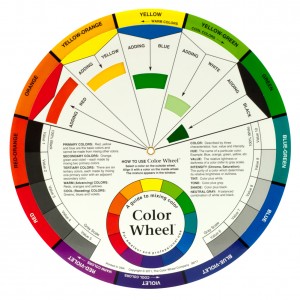Color Profiling & Complimentary Colors
To understand “Color Profiles” (Color Analysis) the very first thing to understand is the basic color wheel
P = PRIMARY COLORS are always Red, Yellow & Blue.
2nd = SECONDARY COLORS come from mixing two primary colors together.
(red + yellow =) Orange, (yellow + blue =) Green, (blue + red =) Violet
Complimentary Colors
The colors that are opposite one another on a color wheel are called complimentary.
Basically, complimentary colors “compliment” one another. They look good together, not only that but when mixed together or overlaid…they “neutralize” one another. That’s pretty much all there is to it. This is useful to apply to many things…painting rooms, decorating, putting together a wardrobe, a flower arrangement, and of course…applying makeup. On one level understanding complimentary colors can help enhance features, like your hair or eye color. As well, they can be used to help hide imperfections….like ruddiness, dark circles, blemishes, bruising, etc. The chart below shows the basic corrector colors, and what colors they conceal.
The interesting thing to also note, is that complimentary colors (opposite each other on the color wheel) are also paired in warm to cool colors. It only makes sense that when hot and cold are mixed together…they neutralize each other out. That might be easier to remember for some people. That if you want to hide a warm colored problem, use a cooler color, and use a warm tone to conceal a cooler problem. Warm and cool colors can be a little tricky, but when in doubt go with what feels right. Red for instance….on the orange side is warm, and on the blue side (more of a wine or burgundy) is a cool color. Don’t think that red, orange, yellow are always warm, and blue, green, and violet are always cold. Although….this is basically the case.
So, the next step would be figuring out if your skin-tone is warm or cool? Once you know what it is…you know what it is…always! It doesn’t change, even with a tan. Most often “seasons” are used to describe skin-tones, but this can sometimes prove confusing. Generally…winters & springs are COOL, while autumns & summers are warm…but like the color-wheel above…people can fall in middle groups. Cool skin-tones will have a blue or pinkish “undertone”, while warm tones have a golden “undertone”. Undertone is what’s important! Basically the rule is as follows….pink-blueish undertones are COOL, and golden-yellow undertones are WARM. Olive complexions can fall to either side depending on whether they’re a golden-green (warmer), or a green-golden (cooler).
Tips for figuring out your skin-tone:
|
SPRING
Hair: Golden blonde, golden brown or red |
SUMMER
Hair: Ash blond, light ash brown (ash being void of any highlights) |
AUTUMN
Hair: Golden brown, red, auburn or chestnut |
WINTER
Hair: black, ash black brown without highlights |



Leave a Reply
Want to join the discussion?Feel free to contribute!